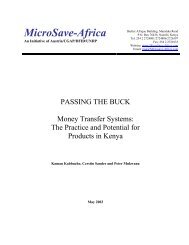Create successful ePaper yourself
Turn your PDF publications into a flip-book with our unique Google optimized e-Paper software.
Photo courtesy <strong>of</strong> Marcosleal<br />
An Unusual Expense<br />
In 1979, Tom Armor and Peter Weisel were winding up<br />
the week working on the Arusha project in Tanzania.<br />
Normally they would fly to Nairobi, Kenya, to take a<br />
plane out, but that day they learned that as part <strong>of</strong> a<br />
dispute over tourism revenue, Tanzania had closed<br />
its borders to motorized vehicles. Weisel and Armor<br />
would have to fly to Ethiopia and then Kenya, at great<br />
expense. At their hotel bar, however, they encountered<br />
a Belgian tour operator who provided views <strong>of</strong> wildlife<br />
via hot air balloon. He <strong>of</strong>fered to sell the two one <strong>of</strong> his<br />
nonmotorized conveyances.<br />
“The story gets long,” Armor explained later, “but<br />
more to the point it fell to me to list ‘one hot air balloon—$600’<br />
on my expense account upon finally returning<br />
to the United States.” When the <strong>DAI</strong> <strong>of</strong>fice queried<br />
Armor about the expense, he was ready: he produced a<br />
clipping from a Kenyan newspaper headlined “Travelers<br />
Reach Nairobi by Balloon.”<br />
16<br />
load everything up with targets—this many farmers, this many<br />
acres, this many tons <strong>of</strong> maize year by year by year, this many<br />
bridges and this many roads—then you’re probably going<br />
to sink the project” from too many unpredictable things that<br />
crop up during implementation. North Shaba did not sink—<br />
<strong>DAI</strong> adapted. At one point, when the U.S. General Services<br />
Administration had failed to order, let alone deliver, heavy<br />
equipment for road and bridge construction, USAID turned<br />
to <strong>DAI</strong> and added funds for procurement to the contract.<br />
“We didn’t say no,” Barclay recalled. “We said we had better<br />
find out how to order and deliver backend loaders and dump<br />
trucks.”<br />
North Shaba accounted for more than one-quarter <strong>of</strong> <strong>DAI</strong>’s<br />
revenues by 1979, but it was joined by several other contracts<br />
far larger than anything the founders had imagined just a few<br />
<strong>years</strong> before. The Integrated Rural Development Project, conducted<br />
in partnership with North Carolina’s Research Triangle<br />
Institute (RTI), first managed by Peter Weisel and later by<br />
Barclay and George Honadle, began in 1978 and provided an<br />
umbrella for 14 subprojects—later expanded to 24—that encompassed<br />
a range <strong>of</strong> initiatives from monitoring and evaluation<br />
systems to management studies and farmer organization<br />
workshops across the globe. The Indonesia Provincial Area<br />
Development Program (PDP), launched that same year, was<br />
a flexible project experimenting with decentralized management<br />
and planning in two provinces, Central Java and Aceh.<br />
Like North Shaba, PDP had a rocky first year, but with lots <strong>of</strong><br />
hands-on attention from Mickelwait, <strong>DAI</strong> was able to turn it<br />
around and earned praise from USAID and several extensions<br />
<strong>of</strong> the contract that ran up to 1984.<br />
The year 1979 brought two more sizable implementation<br />
contracts. SMDP in Sudan, like North Shaba, had deep roots.<br />
Don Humpal, an agricultural development specialist and<br />
Peace Corps veteran, had joined <strong>DAI</strong> in late 1977, shortly



